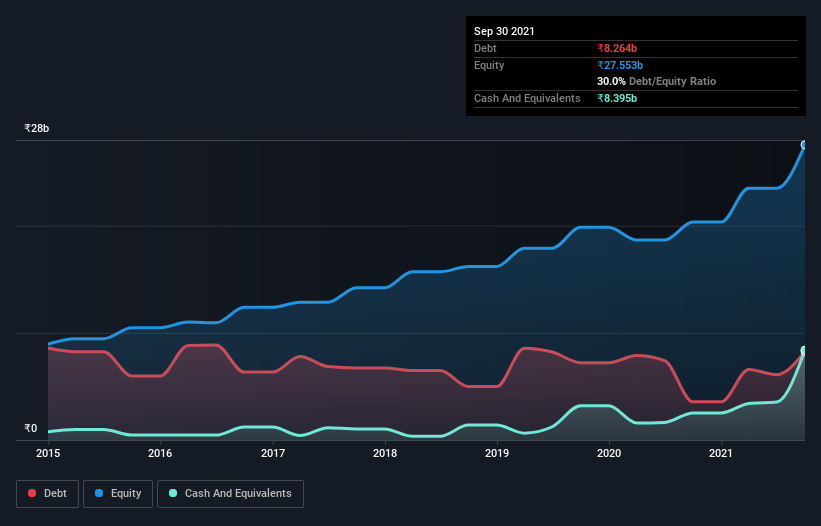Howard Marks put it nicely when he said that, rather than worrying about share price volatility, 'The possibility of permanent loss is the risk I worry about... and every practical investor I know worries about.' So it seems the smart money knows that debt - which is usually involved in bankruptcies - is a very important factor, when you assess how risky a company is. As with many other companies K.P.R. Mill Limited (NSE:KPRMILL) makes use of debt. But the real question is whether this debt is making the company risky.
When Is Debt A Problem?
Debt assists a business until the business has trouble paying it off, either with new capital or with free cash flow. Ultimately, if the company can't fulfill its legal obligations to repay debt, shareholders could walk away with nothing. While that is not too common, we often do see indebted companies permanently diluting shareholders because lenders force them to raise capital at a distressed price. Having said that, the most common situation is where a company manages its debt reasonably well - and to its own advantage. When we examine debt levels, we first consider both cash and debt levels, together.
See our latest analysis for K.P.R. Mill
What Is K.P.R. Mill's Debt?
As you can see below, at the end of September 2021, K.P.R. Mill had ₹8.26b of debt, up from ₹3.56b a year ago. Click the image for more detail. However, it does have ₹8.39b in cash offsetting this, leading to net cash of ₹130.4m.

How Healthy Is K.P.R. Mill's Balance Sheet?
Zooming in on the latest balance sheet data, we can see that K.P.R. Mill had liabilities of ₹6.48b due within 12 months and liabilities of ₹5.04b due beyond that. Offsetting these obligations, it had cash of ₹8.39b as well as receivables valued at ₹4.65b due within 12 months. So it actually has ₹1.53b more liquid assets than total liabilities.
Having regard to K.P.R. Mill's size, it seems that its liquid assets are well balanced with its total liabilities. So while it's hard to imagine that the ₹169.9b company is struggling for cash, we still think it's worth monitoring its balance sheet. Simply put, the fact that K.P.R. Mill has more cash than debt is arguably a good indication that it can manage its debt safely.
Even more impressive was the fact that K.P.R. Mill grew its EBIT by 123% over twelve months. That boost will make it even easier to pay down debt going forward. When analysing debt levels, the balance sheet is the obvious place to start. But ultimately the future profitability of the business will decide if K.P.R. Mill can strengthen its balance sheet over time. So if you want to see what the professionals think, you might find this free report on analyst profit forecasts to be interesting.
Finally, a business needs free cash flow to pay off debt; accounting profits just don't cut it. K.P.R. Mill may have net cash on the balance sheet, but it is still interesting to look at how well the business converts its earnings before interest and tax (EBIT) to free cash flow, because that will influence both its need for, and its capacity to manage debt. During the last three years, K.P.R. Mill produced sturdy free cash flow equating to 55% of its EBIT, about what we'd expect. This free cash flow puts the company in a good position to pay down debt, when appropriate.
Summing up
While we empathize with investors who find debt concerning, you should keep in mind that K.P.R. Mill has net cash of ₹130.4m, as well as more liquid assets than liabilities. And it impressed us with its EBIT growth of 123% over the last year. So is K.P.R. Mill's debt a risk? It doesn't seem so to us. The balance sheet is clearly the area to focus on when you are analysing debt. However, not all investment risk resides within the balance sheet - far from it. To that end, you should learn about the 2 warning signs we've spotted with K.P.R. Mill (including 1 which shouldn't be ignored) .
If you're interested in investing in businesses that can grow profits without the burden of debt, then check out this free list of growing businesses that have net cash on the balance sheet.
Valuation is complex, but we're here to simplify it.
Discover if K.P.R. Mill might be undervalued or overvalued with our detailed analysis, featuring fair value estimates, potential risks, dividends, insider trades, and its financial condition.
Access Free AnalysisThis article by Simply Wall St is general in nature. We provide commentary based on historical data and analyst forecasts only using an unbiased methodology and our articles are not intended to be financial advice. It does not constitute a recommendation to buy or sell any stock, and does not take account of your objectives, or your financial situation. We aim to bring you long-term focused analysis driven by fundamental data. Note that our analysis may not factor in the latest price-sensitive company announcements or qualitative material. Simply Wall St has no position in any stocks mentioned.
Have feedback on this article? Concerned about the content? Get in touch with us directly. Alternatively, email editorial-team (at) simplywallst.com.
About NSEI:KPRMILL
K.P.R. Mill
Operates as an integrated apparel manufacturing company in India and internationally.
Flawless balance sheet average dividend payer.
Similar Companies
Market Insights
Community Narratives



